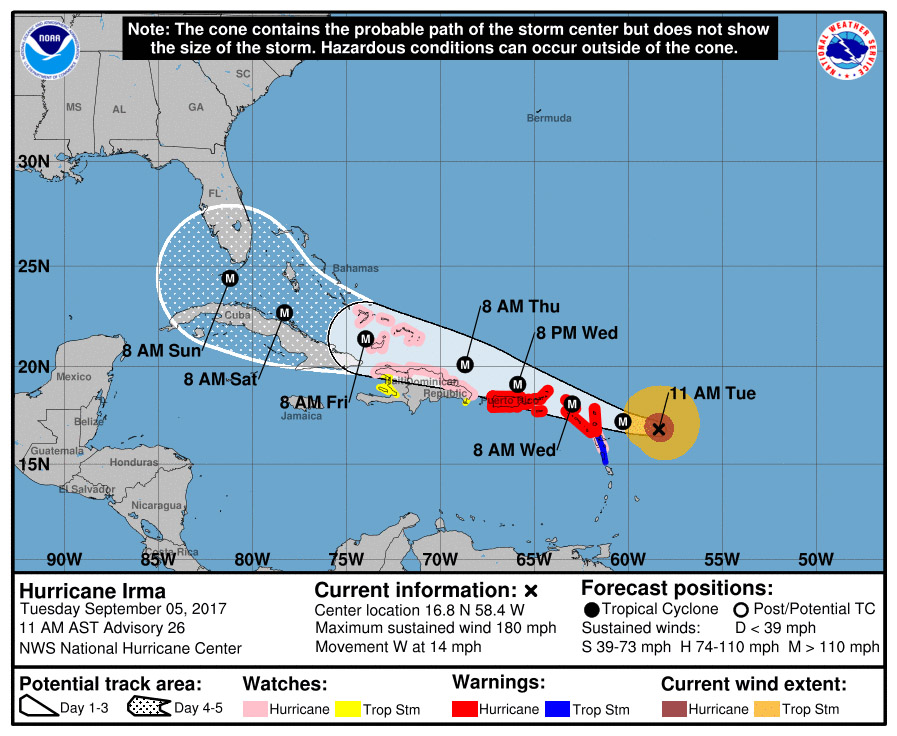Unless you’ve been living under a rock the past week (and if you have, please call us!), you should definitely know that a very dangerous Category 5 hurricane is making its way towards Florida. In fact, Hurricane Irma has already broken records as the most powerful Atlantic hurricane ever recorded in terms of wind speed. Please remember that evacuation may be necessary if you are in the path of the storm. You can rebuild your home, but you can’t replace you or your family members’ lives. If a mandatory evacuation notice is posted for your area, please follow it. Even if you are leaving your home behind though, there are many things you can do to help ensure it will be in the best condition possible when you return. These are just a few:
1. Purchase plywood at your nearest hardware store to cover your windows and glass doors. Don’t just cut the wood to the size of the window frames, though, as this isn’t optimal for protecting your windows from a blowout. Instead, find where the wall studs are located along the window frames and measure to a point a just past them. Of course if you own a brick or concrete home this isn’t really an option, so just fit the wood the window frames anyway.


2. Of course the preferable alternative to plywood is to install storm shutters. Simply installing a set bolts around your window frame with wingnuts to secure them gives you a basic system to remove and secure the shutters whenever needed. It is not recommended to keep the shutters on your windows when it is not necessary, as they can rust in place if left for too long and could block an emergency exit in the case of fire in your home.
3. Check the seals on your windows and doors. The hot weather we are used to in the Sunshine State can damage these seals over time. Normally this isn’t much of an issue, but in a situation where flooding and extreme rain may occur there may massive damage to the interior of your home due to water.
4. If your area is in danger of flooding, use sandbags to protect your home. Many of us in Brevard County live in a coastal community, so this is especially relevant. Empty sandbags can be purchased at most hardware stores or online retailers. In the case of an emergency (such as the one we are currently having), your local government will likely supply them to residents.
5. Inspect your roof to make sure there are no missing or cracked shingles. If these are exposed during a hurricane it can lead to even more serious roof damage and possible leaks in your home. Remember, water damage is almost always costly and your roof is the easiest point of entry for water into your home.
6. Check your gutters to make sure they are clear of any leaves or debris. Full gutters will impede the flow of water from a Hurricane’s heavy rains and likely lead to damage of both the gutters and the roof.
7. Remove any lawn and patio furniture or decorations and store them inside somewhere. We aren’t worried so much about the safety of these items as the safety of others. In the middle of a hurricane these objects can be turned into dangerous projectiles posing a serious threat to life and property. Other things that could become missiles are trash cans, recycling bins, and weak or dead tree limbs
8. If you do decide to evacuate, make sure to turn off your water and hot water heater. Damage to pipes or the heater can cause leakage and terrible water damage to the home. Also unplug any electric devices you have (except your fridge) to reduce the likelihood of an electrical fire occurring. Lastly, make sure to throw out any perishable food you are not bringing with you. If power is lost for an extended period time, food can rot and attract bugs.
Whatever you do, just make sure to stay safe and remember to take every hurricane seriously.

Kyle McCuller
Licensed Real Estate Agent
